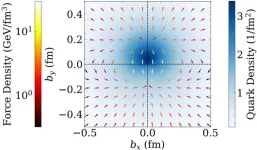(Press-News.org) COLUMBUS, Ohio – The combination of prescribed central nervous system stimulants, such as drugs that relieve ADHD symptoms, with prescribed opioid medications is associated with a pattern of escalating opioid intake, a new study has found.
The analysis of health insurance claims data from almost 3 million U.S. patients investigated prescribed stimulants’ impact on prescription opioid use over 10 years, looking for origins of the so-called “twin epidemic” of combining the two classes of drugs, which can increase the risk for overdose deaths.
“Combining the two drugs is associated with an increase in overdose deaths. This is something we know. But we didn’t know whether stimulant use has a causal role in high use of opioids, so we conducted a big data analysis of how these two patterns interacted over a long period of time,” said senior study author Ping Zhang, associate professor of computer science and engineering and biomedical informatics at The Ohio State University.
“What we found is that if someone is taking a stimulant and an opioid at the same time, they’re generally taking a high dose of the opioid,” he said. “And if the patient in this study population takes the stimulant before beginning opioid use, they are more likely to have higher doses of subsequent opioids.”
The study was published Feb. 17 in The Lancet Regional Health – Americas.
The research team obtained data on 22 million patients with 96 million opioid prescriptions from MarketScan Commercial Claims and Encounters, a large U.S. health insurance database. Researchers established a cohort for this study of 2.9 million patients with an average age of 44 who had at least two independent opioid prescriptions between 2012 and 2021.
Because these prescriptions included a range of oral formulas – codeine, hydrocodone, methadone, oxycodone, morphine and others – researchers standardized every prescription to morphine milligram equivalents (MME) and calculated each patient’s monthly intake of opioids. The MME computation from electronic health records was previously co-developed by co-senior author Wenyu Song, an instructor at Harvard Medical School.
First author Seungyeon Lee, a PhD student in Zhang’s lab, used statistical modeling and classified patients into five baseline groups of opioid dosage trajectory over the 10-year study period: very low-dose, low-dose decreasing, low-dose increasing, moderate-dose increasing and high-dose sustained use.
“Some patients had stable low-dose opioid use, while others had increasing or high dose patterns over time,” Lee said.
Of the total cohort, 160,243 patients (5.5%) also were prescribed stimulants. The addition of a monthly calculated cumulative number of stimulant prescriptions to the model and statistical analysis showed a shift in the trajectory groups. Characteristics that could serve as risk factors for increasing opioid use also emerged in the data, Lee said.
Moderate-dose increasing and high-dose groups had an overall higher average MME and a higher proportion of patients with diagnoses of depression, anxiety and attention-deficit/hyperactivity disorder compared to other groups. The low-dose increasing group also had a higher proportion of patients with ADHD compared to the low-dose decreasing group.
The most common diagnoses linked to co-prescription of stimulants and opioids were depression and ADHD or ADHD and chronic pain.
“This was an important finding, that many patients with ADHD and depression, also experiencing chronic pain, have an opioid prescription,” said Zhang, also a core faculty member in the Translational Data Analytics Institute at Ohio State. “This cohort represents a very realistic health care problem.”
Even taking those factors into account, the model showed that stimulant use was key to driving up the odds that patients who took both stimulants and opioids would belong to a group of people who increased their doses of opioids.
“Stimulant use before initiating opioids and stimulant co-prescription with opioids are both positively associated with escalating opioid doses compared to other factors,” Lee said.
Analysis of geographic and gender data also offered some clues to opioid use patterns in the United States. Patients in the South and West regions had higher total opioid intakes over the 10-year study period compared to the Northeast and North Central regions, with the highest frequency of opioid prescriptions in the South and higher MMEs per prescription in the West. Males also had higher average daily opioid intakes than females.
The results linking high opioid doses and stimulant use suggest stimulants may be a driving force behind the emergence of the twin epidemic and offer evidence that regulation of stimulant prescribing may be needed for patients already taking prescription opioids, the researchers said. In addition to the increased risk of overdose death, co-using prescription stimulants and opioids can increase the risk for cardiovascular events and mental health problems, previous research has shown.
Zhang’s Artificial Intelligence in Medicine Lab focuses primarily on using AI to aid in clinician decision making, and these findings are part of a larger project aimed at development of safer personalized treatment recommendations for people who are prescribed both opioids and stimulants.
“We want to reduce the risk of opioid- or stimulant-related adverse drug events in real-world practice,” Zhang said.
This work was funded by the National Institute of General Medical Sciences, the National Institute on Drug Abuse and the National Science Foundation.
Additional co-authors were David Bates of Harvard Medical School and Richard Urman, chair of anesthesiology in Ohio State’s College of Medicine.
#
Contact: Ping Zhang, Zhang.10631@osu.edu
Written by Emily Caldwell, Caldwell.151@osu.edu; 614-292-8152
END
As the severity of climate change and carbon emissions becomes a global concern, technologies to convert carbon dioxide (CO₂) into resources such as chemical fuels and compounds are urgently needed. Dr. Dahee Park’s research team from the Nano Materials Research Division at the Korea Institute of Materials Science (KIMS), has collaborated with Professor Jeong-Young Park’s team from the Department of Chemistry at KAIST to develop a catalyst technology that significantly enhances the efficiency of carbon dioxide (CO2) conversion.
Conventional ...
Mechanochemistry using a ball mill demonstrates versatility for generating academically and industrially significant organolithium compounds.
Organolithium compounds, molecules containing a carbon–lithium bond, are excellent precursors for building new carbon–carbon and other carbon–heteroatom bonds. They are widely utilized in both academia and industry for their applications in polymer synthesis, pharmaceuticals, and general organic synthesis. A conventional method for generating organolithiums is done ...
Rubidium could be the next key player in oxide-ion conductors. Researchers at Institute of Science Tokyo have discovered a rare rubidium (Rb)-containing oxide-ion conductor, Rb₅BiMo₄O₁₆, with exceptionally high conductivity. Identified through computational screening and experiments, its superior performance stems from low activation energy and structural features like large free volume and tetrahedral motion. Its stability under various conditions offers a promising direction for solid oxide fuel cells and clean energy technologies.
Oxide-ion ...
Houston, we have a problem. The ‘Space City’ boasts 50 buildings over 150 meters tall. These were designed to withstand hurricanes, to which Texas is prone. But on May 16th, 2024, a derecho – a wide, long-lived windstorm associated with rapidly moving showers or thunderstorms – managed to cause unexpected damage to many of the tall buildings downtown. The socio-economic impact was significant, due to traffic disruptions, businesses temporarily closing, and the need for repairs.
Why ...
Optical atomic clocks can increase the precision of time and geographic position a thousandfold in our mobile phones, computers, and GPS systems. However, they are currently too large and complex to be widely used in society. Now, a research team from Purdue University, USA, and Chalmers University of Technology, Sweden, has developed a technology that, with the help of on-chip microcombs, could make ultra-precise optical atomic clock systems significantly smaller and more accessible – with significant benefits for navigation, autonomous vehicles, and geo-data monitoring.
Today, our mobile phones, computers, ...
Scientists have now mapped the forces acting inside a proton, showing in unprecedented detail how quarks—the tiny particles within—respond when hit by high-energy photons.
The international team includes experts from the University of Adelaide who are exploring the structure of sub-atomic matter to try and provide further insight into the forces that underpin the natural world.
“We have used a powerful computational technique called lattice quantum chromodynamics to map the forces acting inside ...
Four young children have gained life-changing improvements in sight following treatment with a pioneering new genetic medicine through UCL Institute of Ophthalmology and Moorfields Eye Hospital, with the support of MeiraGTx.
The children were born with a severe impairment to their sight due to a rare genetic deficiency that affects the AIPL1 gene. The condition, a form of retinal dystrophy, means those affected are born with only sufficient sight to distinguish between light and darkness. The gene defect causes ...
Workplace bullying affects not only the employee’s sleep but their partner’s too, according to new research published today.
Exposure to bullying by superiors and/or colleagues has been linked to a variety of negative health outcomes, such as sleep problems.
Now research by the University of East Anglia (UEA) in the UK, and Complutense University of Madrid and Seville University in Spain, sheds light on the short-term consequences of workplace bullying on various indicators of sleep.
These include waking up too early (sleep severity), interference with daily life (sleep impact) and dissatisfaction with own sleep (sleep satisfaction).
Writing in ...
A new study led by the University of Cambridge has revealed that as our springs and summers get hotter and drier, the UK wildfire season is being stretched and intensified. More fires, taking hold over more months of the year, are causing more carbon to be released into the atmosphere as carbon dioxide.
Fires on peatlands, which are carbon-rich, can almost double global fire-driven carbon emissions. Researchers found that despite accounting for only a quarter of the total UK land area that burns each year, dwarfed by moor and heathland, peatland fires have caused up to 90% of annual UK fire-driven carbon emissions since 2001 – with emissions ...
A new USC study reveals a dramatic surge in building collapses in the ancient Egyptian port city of Alexandria, directly linked to rising sea levels and seawater intrusion.
Once a rare occurrence, building collapses in Alexandria — one of the world’s oldest cities, often called the “bride of the Mediterranean” for its beauty — have accelerated from approximately one per year to an alarming 40 per year over the past decade, the researchers found.
“The true cost of this loss extends far beyond bricks and mortar. We are witnessing the gradual disappearance of historic coastal ...






